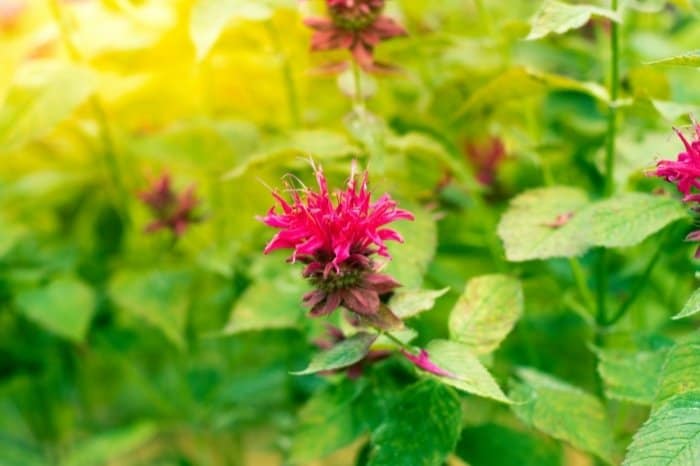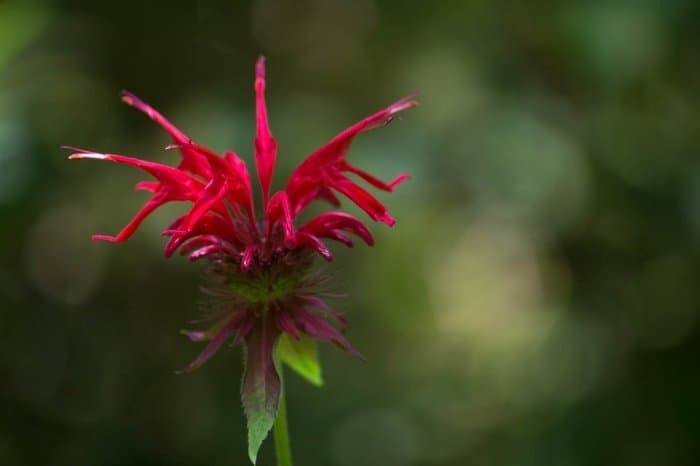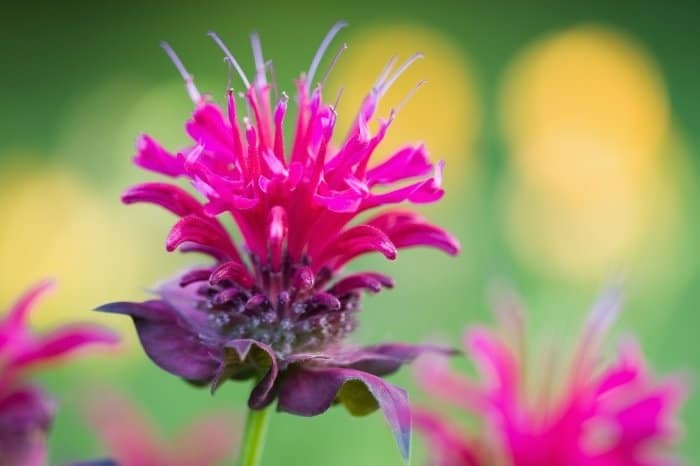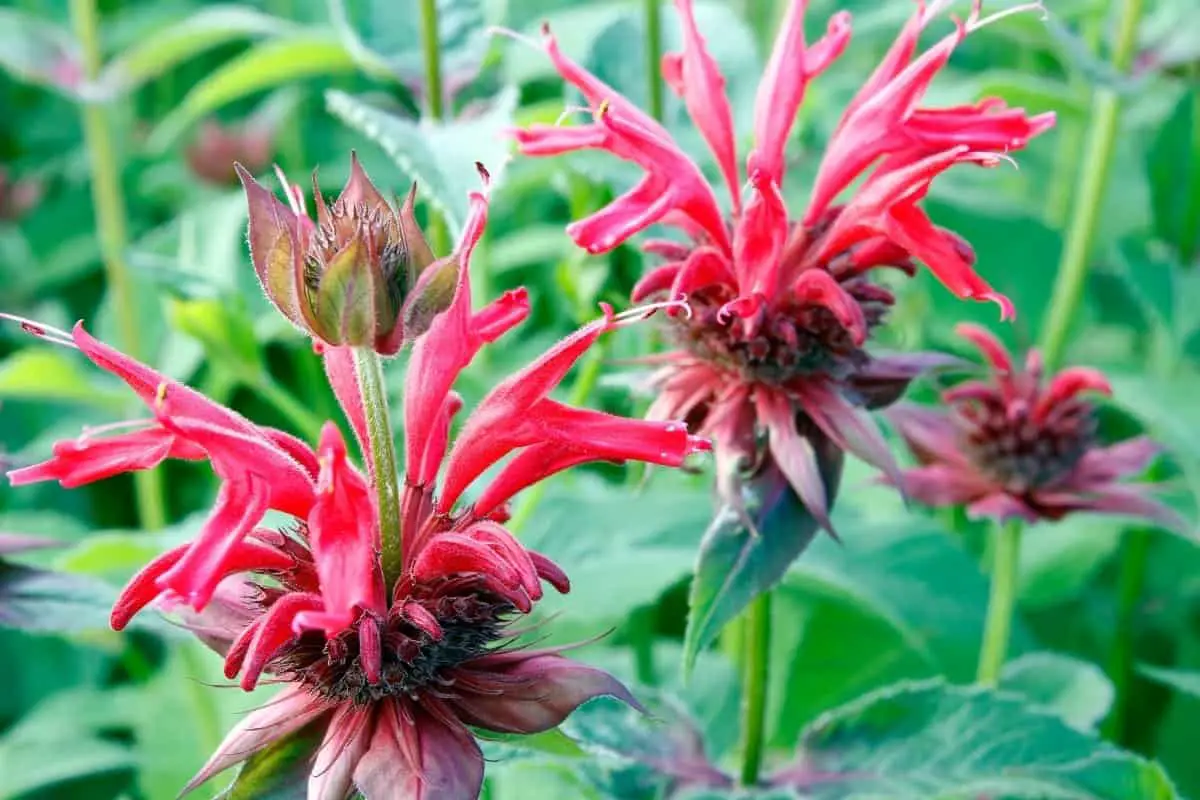Last Updated on January 17, 2023 by Urska
Do you want to know where to plant bee balm or where it can thrive best in your garden, or which USDA zones it does best?
The Bee balm plant is a North American plant that thrives in woodland areas. This plant is attractive to bees, hummingbirds, and butterflies, making it an ideal plant for your garden. It has daisy-shaped flowers with tubular petals coming in shades of pink, red-purple, and white.
Bee balm plants are perennial, and they come back year after year, adding and cheerful colour to your garden.
What Is Bee Balm?
The Bee balm or bees balm plant is a perennial flowering herb that belongs to the mint family. Like mint, it has opposite leaves, square stems, and creeping rhizomes spreading rapidly under the soil.
The Bee balm plant comes in a few varieties but the most commonly cultivated one is M.didyma. This variety has bright red tufted blossoms and tubular petals.
The Bee balm plant attracts all sorts of pollinators the butterflies, bees, and hummingbirds. It has delightfully fragrant, is highly medicinal and is edible testing like mint and oregano. This plant has a long history of human use in the culinary section.
Where To Plant Bee Balm
Bee balm plants thrive in USDA hardiness zones 3 to 9. It is best grown in full sun, although it tolerates shade in water places. It can benefit from the afternoon shade and morning sun. This protects your plants it from too much heat to lengthen their flowering season.
In most cases, bee balm is not picky about where it grows. It can thrive even in heavy clay soils, although it prefers nutrient-rich soil in a ph value of 6 and 7.
Select an area with well-draining soil and good air circulation so that your plans do not develop mildew. When planting another good compost manure to give your soil the nutrients, it requires. Once you plant, mulch your plants to help improve the soil quality airflow and drainage. The mulch will also keep the weeds from growing.
Planting Bee Palm
There are several ways to propagate bee balm. You can grow it from seed cuttings or divisions.
Growing From Seed
Bee balm seeds can take a long time to germinate; anywhere from 10 to 40 days is normal. To help your seeds germinate, it is best to stratify them before planting.
To do this, place your seeds in a plastic bag full of sand to keep the moisture and put them in your fridge for at least a month. Remove the seeds from the refrigerator and broadcast them in your garden in early spring. Ensure that you plant your seeds a few weeks before the last frost at the beginning of spring.
Bee Balm Seeds for Planting Outdoor, 1000+ Seeds, Monarda Didyma Flower Perennial, Non GMO
Before planting, amend your soil with a bit of compost manure to enrich it. Provide your seeds with enough light, so there is no need to cover them.
Growing From Cuttings
It is tricky to grow to be bound from cutting, but it is possible. To do so, select a new screen grove from the tips of the stems and cut at least 6 inches below a set of leaves. Place these cuttings in a small pot with perlite, peat moss, or vermiculite. You can also apply rooting hormone to help speed up the process. Water your cuttings well and place a plastic bag over each pot to help retain moisture.
In about 2 to 3 weeks, your stems will begin to have roots, and you can remove the bag and repot your cuttings in potting soil.
Growing From Divisions
The easiest way to plant bee balm is by division. Carefully dig up any plants that you wish to divide in the spring season. Gently shake off their soil to loosen it and cut through the fig rolls with pruning shears full stop carefully pulls the sections apart, ensuring that each section has enough roots attached to regrow. Each section should have at least a few inches of root on each piece.
For any damaged or broken stems trimmed them before replanting your division in your garden beds or pots. Ensure that you space them to at least 18 to 24 inches apart.

How To Plant Bee Balm From Seed
Bee balm can be seeded directly into the garden, but most said vendors recommend starting them indoors and transplanting the seedlings.
When Starting Your Seeds Indoors, Follow These Steps
6 to 8 weeks before your local last frost date, sow your bee balm seeds are in small pots or seed trays. Press them gently into the potting soil. The bee balm requires sunlight to germinate, so do not cover them with soil; leave them the same way you planted them. Place the seeded pots or trees in a warm or sunny spot indoors. Ensure that the potting soil is evenly moist until the seeds germinate.
Once your seed germinates continue watering them regularly until your local last frost date has passed.
Harden off your seedlings over the next few days by taking them outdoors for a few hours each day. Put them in a location that has dappled sunlight so they can get the best reaction before returning them indoors. This gives your plants time to adequately adjust to outdoor temperatures before the big move to the garden.
Choose a location in your garden that gets full sun or if you live in hotter climates, choose a location that gets partial sun whole morning sun with afternoon shade. Ensure that the spot you select has fertile, neutral, or slightly acidic and well-drained soils.
Use a big spade to dig a large enough hole to accommodate the seedlings root ball and some of the potting soil. Space the bee balm plants at least 12 to 14 inches apart and leave them to grow.

Pruning Division And Seed Saving For Your Bee Balm Plants
Bee balm tends to spread widely. You can therefore divide it every few years in the spring to keep it thriving. The division also helps it from spreading too rapidly in areas you don’t want it to grow.
To encourage spreading, pinch back the top set of leaves on each stem when they are a couple of feet tall in early spring. This will facilitate lateral spreading allowing plants to spread out before they flower.
To encourage a more extended flowering season, stagger alley pinching over a few weeks and prune about a third of the stems each week.
Throughout the season, it is essential to deadhead your blooms to encourage more flooding and reblooming in the summer. Use the picked Bloons for medicine, bouquets, or food.
Bee balm allows you to save seeds by collecting mature seeds a few weeks after the flowers bloom. These seeds can be used in the following planting season. Place a bowl or a bag under a stem and shake the stem gently to collect the seeds. If brown seeds fall out, they are ready for harvest. Refrigerate these seeds until you are ready to plant them.
Gardening Tips For Where To Plant Bee Balm
- Plant them in well-draining soil with a good air circulation
- Choose a site in the centre or back of a garden bed so that these flowers add a burst of colour and depth as they flower. These flowers tend to be taller than many other types.

- Ensure that environmental facts are perfect for encouraging blooming.
- Once the stem has finished flowering, teammate back to the ground or pinch it off to encourage new stems to grow
Final Thoughts
Whether you choose to grow the standard, dwarf, or mildew resistant variety you can never go wrong with a bee balm. And now that you know where to plant bee balm go ahead and try growing your own.
Caroline is a gardener who loves to get down to the nitty–gritty of gardening. She proudly proclaims herself as a ‘dirt worshipper‘ and can often be found deep in the garden, covered in soil and singing to her plants. As a self–proclaimed ‘plant whisperer‘, Caroline believes that plants need love and attention just like any other living thing, and she loves to give them both. When she‘s not tending to her garden, you can often find her researching the latest gardening trends, or teaching others how to make their gardens thrive



